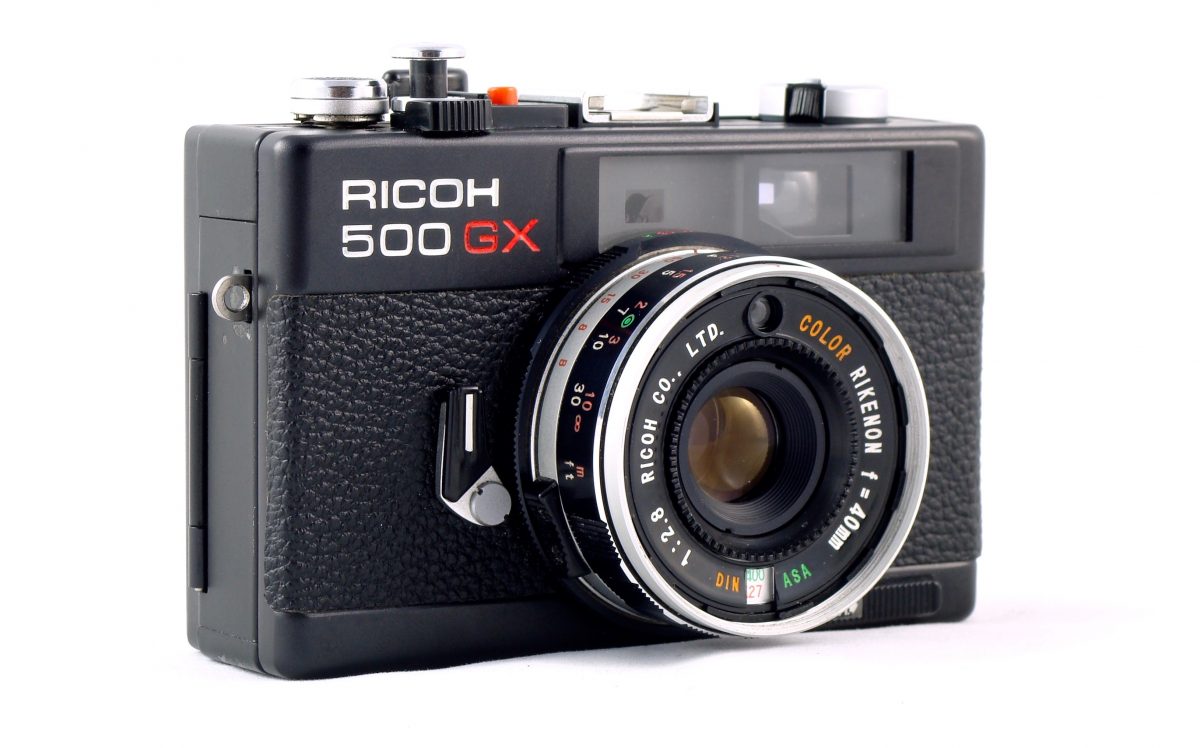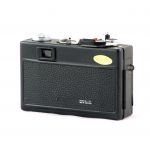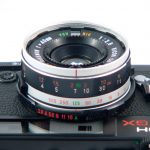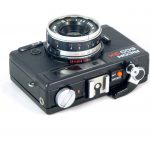One chilly morning of car boot sale in the region of Paris, I stumbled upon a small camera that turned out to be a really serious rangefinder: the Ricoh 500GX. And it’s been love ever since!
Introduction
Sold from 1976 to 1980, the 500GX is a really compact and robust camera, made out of metal. Its reasonable weight, 420g, makes it easy to handle, while its slim size makes it easy to carry away and even drop inside a large jacket pocket. My specimen is all black, but Ricoh also sold a more common silver version.
The lens is a Color Rikenon f/2.8 and focal length is a versatile 40mm, even if I would dream it a bit shorter for street photography. Focusing is done through a coupled rangefinder and goes as close as 90cm from subjects.
The default aperture priority mode is easily disabled to get the Ricoh 500GX into full manual mode.
Shutter speeds go from 1/8 s to a comfy 1/500 s that enables the use of the widest aperture. Long exposure is possible by using the Bulb position. Flash sync is supported at all speeds. Things are getting serious when you start looking at auto exposure: the default exposure mode is a very convenient aperture priority. The selected aperture is shown facing the meter needle inside the viewfinder. Note that the meter is located just above the lens, and is covered by whatever lens filter you may need. More importantly, this default mode is easily disabled to get the Ricoh 500GX into full manual mode.
The viewfinder displays a clear but tiny rangefinder patch. On the right side, the metering needle runs through the different possible apertures. A light press on the shutter release locks the selected aperture and lets you compose your frame with the desired exposure. Over and under-exposure do not prevent the camera from taking the picture, as would a New Canonet 28. It is too bad, though, that the lens barrel had to take so much space in the viewfinder!
Tormented ergonomics
Inside our viewfinder, a small capital “M” reminds us whenever the auto-exposure mode is disabled. However, nothing indicates the selected aperture in this situation. Actually, either in manual or auto-exposure modes, the 500GX does not display anything about the speed: be careful not to select slow speeds! This only foreshadows all the oddities this camera has with ergonomics.
In my previous post reviewing the Nikon F-501AF, I was unveiling the evolutions of modern autofocusing systems. While at the time Ricoh released its camera there already existed consumer grade rangefinders with advanced designs, such as the Canon P, the 500GX has hard times integrating the new accessories in a body still more compact. It actually shows how uncertain makers were when they integrated the new electronics and creative mechanisms in their cameras.
So, the 500GX is a small very regular black brick, on top of which a mad designer decided to put, here and there, wherever it pleased him, funny buttons and levers.
A mad designer decided to put, here and there, wherever it pleased him, funny buttons and levers
First, the shutter release is quite long. The button actually looks a lot like the end of a cable release transplanted on this small camera. OK, why not? But the lump it creates ensures accidental release whenever you’ll carry the camera with you!
In order to bypass this issue, that came up with the parent iteration of the small Ricoh, designers introduced a new shutter lock lever that users have to turn 45 degrees to get the camera ready. Unfortunately, without any reminder of this shutter lock in the viewfinder, you will undoubtedly curse as I did numerous times against this curious design.
Finally, filling the remaining space on the top cover, a small red blister acts as a battery checker. And in case you ever forget what this red thing does, there is a giant sign with big capital letters saying “BATT CHECKER”. Trust me, you’ll remember what this is.
Because not everything is all black, note the actual good idea: two red/green indicators that tell you quickly if there is film inside the camera (next to the rewind knob) and whether the shutter is cocked (next to the advance lever).
Another novelty since the parent iteration: the 500GX comes with a multi-exposure mechanism. It was fine to separate it from the main cocking system. But was it necessary to place it so far from all other commands, on the complete opposite? Oh, and since this slider button is already unreachable, was it a reasonable idea to pair it with still another type of button, round and flat and so not manipulable that you have to crush it with your finger in order to make it turn a few degrees? Well, at least rest assured, dear Mr. Designer, that no one will ever activate multi-exposure by mistake.
Yet I still love it
Despite all these design flaws, the tiny Ricoh knows how to make itself lovable.
It is very easy to get ready to shoot: use one PR44 battery to bring it to life, the exact same I was recommending in Type 100 Polaroid cameras. But even without battery, you can shoot in manual mode at all speeds, only the light meter won’t be available. If needed, the rangefinder is easily adjustable from outside, under a tiny rounded cap next to the accessory shoe. Do not hope to get your hands inside the beast so easily though, leave this arduous task to professionals.
All the issues mentioned above will only be avoided by the means of a complete and practical learning process using this camera. And the Ricoh 500GX, with the ability to carry it everywhere and anywhere, offers the keys for fulfilling this training. And eventually, this work will be rewarded with high quality pictures.
Some pictures
I’ve been walking around for about a year with the Ricoh 500GX. You will find below some pictures shot in various situations, various light conditions and on various film types: Kodak Ektar 100, Kodak Portra 400, Ilford HP5 Plus 400, and Ilford FP4 Plus 125.
Do not hesitate to ask in the comments if you have questions about the Ricoh 500GX, and please share your pictures shot using this camera with me on Instagram. Have fun !
More info
- As always, check out the black Ricoh 500GX page on Collection-Appareils. The silver version page has more details.
- Infos on the parent iteration, the Ricoh 500G, on Matt Denton’s classic cameras site.
- The 500 GX in my personal collection.





















hi! how did you shot a multiple exposure photo with that?
Hi Nadine. There are two sliding levers on the camera’s face, named “MULTI”. See the picture here : https://manondamoon.com/dsc00202-2/
You do as follow: take your first picture, then rotate the round slider from red marker to the green one, then slide the slider marked “MULTI”. This cocks the shutter, the camera is ready for another shot on the previously exposed frame.
Hi,
How do you use the built in light meter on this camera? Do you need to set the Aperture onto auto and adjust the shutter speed? I can’t work it out. Thanks Kate
Hi Kate,
You’ve got it: the aperture ring is only useful for flash photography or for total manual settings, modes in which the light meter becomes useless.
Set the aperture ring to A, select your shutter speed and the light meter will show the corresponding aperture to get a properly exposed picture in most situations.
Enjoy you camera!
Hi Laurent thank you for responding! Once it’s shown me the corresponding aperture do I need to change it on the lens (taking it off A) to the aperture indicated or leave it? Thanks again in advance!
It is showing the aperture for information only. You need to leave it on A. Advance the film and shoot! 🙂
Thank you so much for your help!
Hey, thanks for the great review and even better photo samples – beautiful 🙂
i have one and is really cool one question, the tripod screw is standard? thanks
Hello Deivid, yes the tripod screw is standard and the same you’ll find on modern cameras.
Hi
Da die Ricoh ja mit einer Queksilberbatterie betrieben wird,gibt es da keine Probleme mit dem Belichtungsmesser ?
Welche Batterien (genaue Bezeichnung ) sollte man alternativ verwenden ?
gruss
Hallo Bernd
I use PR44 Zinc-Air batteries that are quite the same voltage. This way there is no issue with the lightmeter.
Just stumbled upon this great review. I got the black one 2 years ago, and honestly feel like it is the most underrated camera. I paid $150 for mine in mint condition. You did mention the many flaws or unusual design choices, but as your photos show sir, it’s a fantastic performer in skilled hands. I also scored a 500me which has a much better back door and ME slider (a small release button on the slider instead of that crazy dial). I hope you are still shooting away with yours. Cheers!
Hi,
I’ve just bought a silver 500GX from a camera dealer and it seems pristine, the viewfinder was spotless.
Just wondering if the PR44 batteries are hearing aid batteries and if LR44/SR44 batteries are a good substitute.
Hello John, SR44 batteries should do just fine. There will be a voltage difference (1.55V vs 1.45V for PR44 vs. 1.35V for original mercury batteries).
I’m curious if the exposure would differ or if the circuit would have some voltage regulation, so you should probably check the aperture/speed values the camera suggests against another lightmeter (a digital camera or an app on your phone). If any difference, you should be able to compensate by adjusting the ASA value.
Hi. Not sure if you’d ever get this or monitor for replies but I recently bought a Ricoh 500GX off of an online auction. I used an SR44 battery and to compensate (I did some research but it still felt like guesswork), I put in a Lomocolor 100 and set the ISO to 200. The exposures were perfect (imo.)